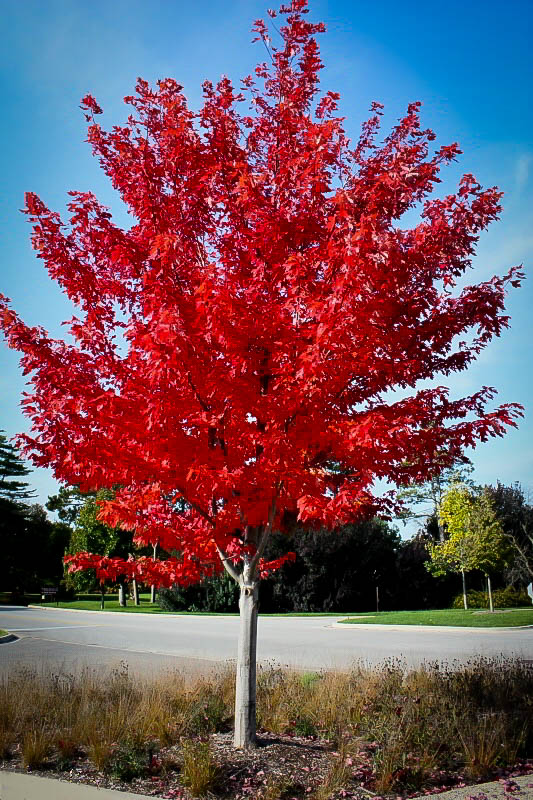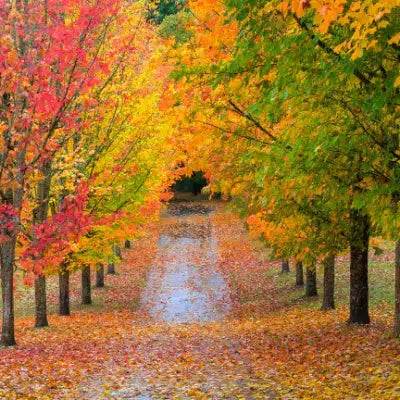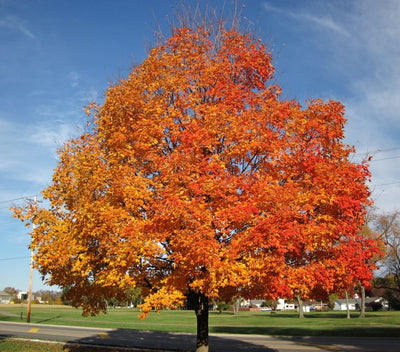Foliage on Trees with the Most Colorful Leaves
As fall begins, the vibrant colors that trees bear is something that stands out the most. While some trees wither and die or transition with color in a monotonous manner, a select few trees are alive with dynamic colors. These trees add brilliant splashes of red, orange, and gold to the landscape and serve as the final addition of color to the garden before winter settles in. If you want to add a show of color to your garden this fall, below are some of the finest trees to consider.
Red Maple
One of the most renowned tree species in North America is the red maple tree. It is exceptionally known for its magnificent fall foliage. During the fall, the red maple trees fascinatingly change to radiant red and orange colors, providing a breathtaking look in whichever landscape it is placed. They can reach heights up to 30-35 feet. They can grow in moist or well-drained soils as well as dry conditions.

The local weather and soil can turn the leaves of the tree's green leaves to remarkably brilliant colors of red, orange, and even yellow. The leaves are serrated and usually 3 to 6 inches long. The Red Maple tree is a good choice for people looking for an attractive tree with vibrant color. They are low-maintenance and thrive in full sun or partial shade.
Growing Tips:
-
Location: Red Maples are sun loving but can withstand some shade.
-
Soil: They can withstand dry soil but prefer/ thrive in moist, well-drained soil.
-
Watering: Regular watering is a must during the first year of planting. They are drought resistant after the first year.
-
Pruning: Prune in order to retain its intended shape and avoid all other kinds of shape pruning.
Red Sunset Maple Tree
The Red Sunset Maple Tree offers vibrant fall foliage, making it an equally beautiful tree, and it matures to around 30 to 60 feet tall with a density spread of 20 to 30 feet. It is one of the fast-growing trees and well-loved for the stunning color of red, orange, and yellow leaves during fall.
With its remarkable Sunset Red Maple tree, one can have the perfect tree in leading sunshine with very low hassle and in various soil types including clay. Also, after this tree has established, a consumer need not worry regarding drought as this tree is drought-tolerant. Pests aren't much of a problem with this tree, but the tree thinker should be cautious of diseases including verticillium wilt and tar spots that lie dormant in the leaves.
With regards to this tree, it has various components to consider in its management including watering, pruning, and fertilization.
Planting the tree during the droughts of spring requires one to regularly water the tree in its first few years.
Tulip Tree
The blossom of this tree has the shape of a tulip and this singular characteristic is what ensures this tree is different, besides its height, from the rest.
Though to others it may not be the tallest or most unique, the eastern North American tree is. So too the other way round, its blossoms are set and enhance spring while its leaves primarily, from this perspective, shape the autumn.
The Tulip tree requires moist, well-drained soil and full sun. Once this tree is established, it can endure periods of drought. The tree’s golden foliage complements the greens of the landscape and adds welcoming color to the area.
Growing Tips:
-
Sunlight: For best color in the fall, plant in full sun.
-
Soil: Moist well-drained soil is preferred and can tolerate drought.
-
Maintenance: For those seeking a tree simple in upkeep, the low-maintenance tulip tree is a great option.
Sugar Maple Tree
The sugar Maple tree is well-known for the syrup it can produce, and is equally admired for its stunning foliage in the autumn. The leaves don the sugar maple’s stunning red, brass, and orange hues. Sugar Maples tower at heights of nearly 100 feet and can be found in countless forests throughout North America.
The sugar maple tree is relatively low-maintenance and makes a great addition to any yard. It's best to avoid clay soil, while well-drained and slightly acidic soil is preferred. Established trees do not require much care, though it can be infringing.
Growing Tips:
-
Sunlight: For full sun, vibrant fall colors become easy to see.
-
Watering: The initial years of any tree require attention, though all trees must be watered on a routine basis.
-
Soil: Sustains light acidic and well-drained dirt.
-
Pruning: Prune as necessary to keep the plant in balance and to remove broken or diseased growth.
Other Trees With Striking Fall Coloration
We focused on a few of the most prominent trees in the area, but there are certainly other trees that could provide a splash of fall color to your landscape. Sweetgum Trees would also make a fantastic addition, as their star-shaped leaves change to bright red, orange, and purple in the fall. Ginkgo Trees also make fantastic additions, as their leaves turn a striking yellow and are shaped like a fan. Black Tupelo Trees (Nyssa sylvatica) also make fantastic additions, as their foliage changes to a striking red and adds to the dramatic appeal of the landscape.
Get and Plant Your Own Fall Trees with Unique Colorful Leaves from TN Nursery
If you would like to add colourful foliage to your yard, you can visit TN nursery. Trees with foliage known for its unique coloration would be sure to add the best possible tree for your yard. You will surely fall in love with the bright colored leaves of the Red Maple and will also enjoy the bright unique of the Tulip Tree. Plant trees immediately so your garden can be colourful and vibrant like the garden of Eden.
FAQs
What is the most colorful fall tree?
Any fall tree being represented is sure to have a multitude of color, but the red maple tree is most associated with fall colors, with leaves that are predominantly red, orange, and yellow. Also present in the fall color map are the Sugar maple and the Sweetgum tree, whose leaves are equally striking during the fall months.
What tree has the reddest leaves in the fall?
The tree with the most red leaves in fall is the red maple tree. This tree is known for having an exceptionally vibrant red color that draws many potential buyers who are eager to color their garden with a bright addition.
What tree is known for golden fall foliage?
The Tulip Tree is sought after for its golden and yellow leaves in the fall. It is true that the tree has large and beautiful tulip leaves shaped flowers in the spring, however its most magnificent craftsmanship is shown through the leaves in autumn.
Which tree has the most beautiful leaves?
The Sugar Maple Tree is believed by many to be the tree with the most magnificent leaves due to its mixture of red, orange, and yellow. But even the Red Sunset Maple and Sweetgum Tree fall under the category of stunning trees, maybe even the Sunset Maple bordering on a blazing surpass.
What is the prettiest tree in the fall?
The Red Maple is arguably the most beautiful tree in autumn. Its red and orange foliage is stunning, but even the Sugar Maple and Tulip Tree add to the most exciting displays of foliage which is a delight for the eye.
What are the downsides of sugar maples?
Although beautiful, sugar maples are prone to disease which can include Verticillium Wilt, as well as the attack of aphids and borers. Also, the sheer size of sugar maples is a problem for a necessary amount of space most homeowners are willing to offer. Things such as pruning and pest monitoring are a must to keep these trees in good health and most suitable for public areas.





